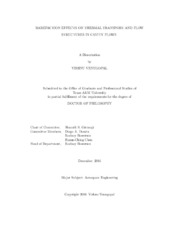| dc.contributor.advisor | Girimaji, Sharath S | |
| dc.creator | Venugopal, Vishnu | |
| dc.date.accessioned | 2017-03-02T16:46:16Z | |
| dc.date.available | 2018-12-01T07:20:45Z | |
| dc.date.created | 2016-12 | |
| dc.date.issued | 2016-10-25 | |
| dc.date.submitted | December 2016 | |
| dc.identifier.uri | https://hdl.handle.net/1969.1/158986 | |
| dc.description.abstract | Accurate simulation and modeling the effects of rarefaction on heat and mass transport is of much interest in high-speed flow applications including hypersonic vehicles and atmospheric re-entry flights. Toward this end, the present work develops numerical schemes appropriate for a wide range of Knudsen numbers and performs analytical investigation of the rarefaction effects. First, the Unified Gas Kinetic Scheme (UGKS) is extended to a wider range of Mach and Knudsen numbers by implementing WENO (Weighted Essentially Non-Oscillatory) interpolation. Direct Simulation Monte Carlo (DSMC) computations are also performed when appropriate for comparison purposes. Though DSMC method is theoretically valid in the entire range of Knudsen numbers (from continuum to free-molecular), real computations with DSMC are limited to rarefied flows as this method demands excessive computational resources to simulate continuum/near-continuum flows.
The effect of rarefaction is examined in the canonical lid-driven flows. In particular, the effect of cavity size (cavity aspect ratio), flow speed (lid Mach number) and degree of rarefaction (global Knudsen number) on flow structures and transport properties in the cavity are examined. The simulations are performed at a wide range of flow regimes (a) subsonic incompressible, subsonic compressible and supersonic (b) Knudsen numbers: continuum, near-continuum, transition and highly rarefied regimes. Flow (vortex) structures and thermal transport are characterized as functions of different flow regimes and cavity size. Mechanism of vortex evolution is investigated at a microscopic perspective.
Parametric studies followed by careful observations and rigorous analyses reveal important insights to the rarefaction effects on the heat and mass transport behavior of canonical 2D cavity flows. The proposed scheme can extensively be used for fluid flows comprising of large density variations whose length scales extend from a macroscale to a molecular scale. | en |
| dc.format.mimetype | application/pdf | |
| dc.language.iso | en | |
| dc.subject | rarefied flows | en |
| dc.subject | gas kinetic method | en |
| dc.subject | cavity flows | en |
| dc.subject | thermodynamic non-equilibrium | en |
| dc.subject | thermal transport | en |
| dc.title | Rarefaction Effects on Thermal Transport and Flow Structures in Cavity Flows | en |
| dc.type | Thesis | en |
| thesis.degree.department | Aerospace Engineering | en |
| thesis.degree.discipline | Aerospace Engineering | en |
| thesis.degree.grantor | Texas A & M University | en |
| thesis.degree.name | Doctor of Philosophy | en |
| thesis.degree.level | Doctoral | en |
| dc.contributor.committeeMember | Donzis, Diego A | |
| dc.contributor.committeeMember | Bowersox, Rodney | |
| dc.contributor.committeeMember | Chen, Hamn-Ching | |
| dc.type.material | text | en |
| dc.date.updated | 2017-03-02T16:46:16Z | |
| local.embargo.terms | 2018-12-01 | |
| local.etdauthor.orcid | 0000-0002-8258-4083 | |


